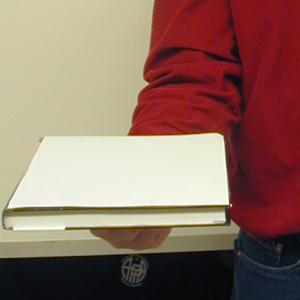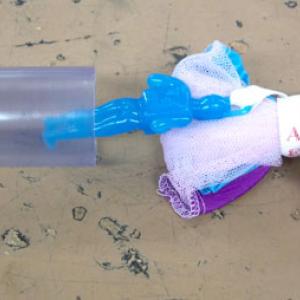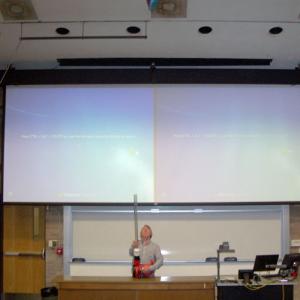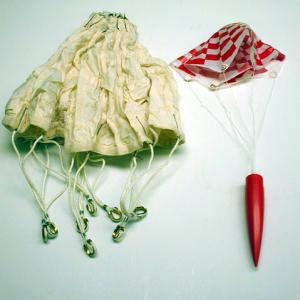College of Liberal Arts & Sciences
1C20.18 - Free-Fall and Air Resistance
See also 2C30.65 in Heat and Fluids.
Hold the note cards horizontally at some height. When you release them the card with the quarter in the middle should float down in a horizontal position, but the card with the quarter toward the edge will turn vertically and fall at a faster rate.
Hold a book in one hand and a piece of paper or note card in the other. Drop them at the same time and observe that the book hits the floor first while the paper only floats down. Repeat the demonstration, only this time place the paper on top of the book. Observe that they travel together at the same rate.
You can also use the parachutes to show how a terminal velocity can be achieved using air resistance. Instead of trying to throw the parachute into the air, use the leaf blower and tube attachment or the long tube and vacuum blower to launch it to the classroom ceiling. Picture D shows the way to fold and insert the parachute with action figure into the tube.
- Paul Hewitt, "Figuring Physics", TPT, Vol. 59, #8, Nov. 2021, p. 659.
- Irany Vera Manrique, Gabriela Rivadeneyra Gutiérrez, and David Alejandro Martínez González, "Kinetic Friction: Time Upward and Downward", TPT, Vol. 57, #3, Mar. 2019, p. 142.
- Paul Hewitt, "Answer to Skydiving Nellie", TPT, Vol. 55, #6, Sept. 2017, p. 370.
- Paul Hewitt, "Skydiving Nellie", TPT, Vol. 55, #5, May 2017, p. 263.
- Elida de Obaldia, Norma Miller, Fred Wittel, George Jaimison, and Kendra Wallis, "Bridging the Conceptual Gap Between Free Fall and Drag-Dominated Regimes", TPT, Vol. 54, #4, Apr. 2016, p. 233.
- Paul Janssen and Ewald Janssens, "Bicycle Freewheeling with Air Drag as a Physics Experiment", TPT, Vol. 53, #1, Jan. 2015, p. 25.
- Wojciech Dindorf, "Simple Terminal Velocity Measuring Device", TPT, Vol. 49, #3, Mar. 2011, p. 190.
- Pirooz Mahazzabi, "When Does Air Resistance Become Significant in Free Fall?", TPT, Vol. 49, #2, Feb. 2011, p. 89.
- Paul Hewitt, "Figuring Physics: Up-Down Time", TPT, Vol. 44, #6, Sept. 2006, p. 335, 390.
- Jan Benacka and Igor Stubna, "Accuracy in Computing Acceleration of Free Fall in the Air", TPT, Vol. 43, #7, Oct. 2005, p. 432.
- Vasilis Pagonis, David Guerra, Sean Chaudurii, Brian Hornbecker, and Nathan Smith, "Effects of Air Resistance", TPT, Vol. 35, #6, Sept. 1997, p. 364.
- Martin Gardner, "Physics Trick of the Month: A Snap and a Drop", TPT, Vol. 32, #9, Dec. 1994, p. 537.
- Christopher Brueningsen, Jason Marinelli, Peter Pappano, and Kenneth Wallace, "Modeling Air Drag", TPT, Vol. 34, #7, Oct. 1994, p. 439.
- Robert Weinstock, "But Not Too Fast, Please", TPT, Vol. 31, #6, Sept. 1993, p. 326.
- A. H. Bachman, "Consequences of Mass and Air Resistance for Falling Bodies", TPT, Vol. 31, #6, Sept. 1993, p. 326.
- Robert Weinstock, "The Heavier They Are, The Faster They Fall - An Elementary Rigorous Proof", TPT, Vol. 31, #1, Jan. 1993, p. 56.
- Richard S. Halada, "Parachutes in the Classroom", TPT, Vol. 31, #1, Jan. 1993, p. 50.
- Paul Hewitt, "Figuring Physics", TPT, Vol. 29, #8, Nov. 1991, p. 514.
- Lewis Epsttein, "Wind Force and Wind Speed", TPT, Vol. 29, #4, Apr. 1991, p. 196.
- Paul Hewitt, "Figuring Physics", TPT, Vol. 29, #1, Jan. 1991, p. 49.
- Frank L. Weichman and Bruno Larochelle, "Air Resistance", TPT, Vol. 25, #8, Nov. 1987, p. 505.
- Margaret Stautberg Greenwood, Charles Hanna, and Rev. John Milton, "Air Resistance Acting on a Sphere: Numerical Analysis, Strobe Photographs, and Videotapes", TPT, Vol. 24, #3, Mar. 1986, p. 153.
- John Bozovsky and Ann Brandon, "The Fall of The Ball", TPT, Vol. 21, #9, Dec. 1983, p. 611.
- Paul Latimer, "Do the Leaning Tower Experiment With One Hand!", TPT, Vol. 17, #5, May 1979, p. 314.
- J. Pantaleone, "How the Air Slow a Closing Book", AJP, Vol. 92, #1, Jan. 2024, p. 7.
- Jan Benacka, "High-Altitude Free Fall Revised", AJP, Vol. 78, #6, June 2010, p. 616.
- David Auerbach, "The Parachute Paradox", AJP, Vol. 62, #11, Nov. 1994, p. 1041.
- D. F. Jones and P. E. Desmier, "Stabilization Parachutes: A Rigid Body Treatment", AJP, Vol. 55, #6, June 1987, p. 538.
- J.C. Lewis and H. Kiefte, "Simple Experiment to Illustrate the Functional Form of Air Resistance", AJP, Vol. 50, #2, Feb. 1982, p. 145.
- Gerald Feinberg, "Fall of Bodies Near the Earth", AJP, Vol. 33, #6, June 1965, p. 501.
- George M. Hopkins, "Falling Bodies - Inclined Plane - The Pendulum", Experimental Science, p. 38.
- John Henry Pepper and Henry George Hine, "Gravitation", The Boy's Playbook of Science, p. 14.
- Martin Gardner, "A Snap and a Drop", Science Tricks, p. 29.
- Martin Gardner, "Galileo Vs. Aristotle", Entertaining Science Experiments with Everyday Objects, p. 84.
- Robert Ehrlich, "D.6. Air Resistance as a Form of Friction", Turning the World Inside Out, p. 44.
- Janice VanCleave, "98. Parachute", Teaching the Fun of Physics, p. 148.
- Janice VanCleave, "30. Same Speed", Physics for Every Kid, 101 Easy Experiment in Motion, Heat, Light, Machines, and Sound, p. 72.
- Bobby Mercer, "Paper Drop", Junk Drawer Physics, p. 25.
- Curt Suplee, "Friction as friend", Everyday Science Explained, National Geographic, p. 28.
- Sara Stein, "Air and Water Toys", The Science Book, p. 163.
- Herb Strongin, “Building a Parachute“, Science on a Shoestring, p. 135.
- Borislaw Bilash II, “Floating Down“, A Demo A Day – A Year of Physical Science Demonstrations, p. 215.
Disclaimer: These demonstrations are provided only for illustrative use by persons affiliated with The University of Iowa and only under the direction of a trained instructor or physicist. The University of Iowa is not responsible for demonstrations performed by those using their own equipment or who choose to use this reference material for their own purpose. The demonstrations included here are within the public domain and can be found in materials contained in libraries, bookstores, and through electronic sources. Performing all or any portion of any of these demonstrations, with or without revisions not depicted here entails inherent risks. These risks include, without limitation, bodily injury (and possibly death), including risks to health that may be temporary or permanent and that may exacerbate a pre-existing medical condition; and property loss or damage. Anyone performing any part of these demonstrations, even with revisions, knowingly and voluntarily assumes all risks associated with them.







